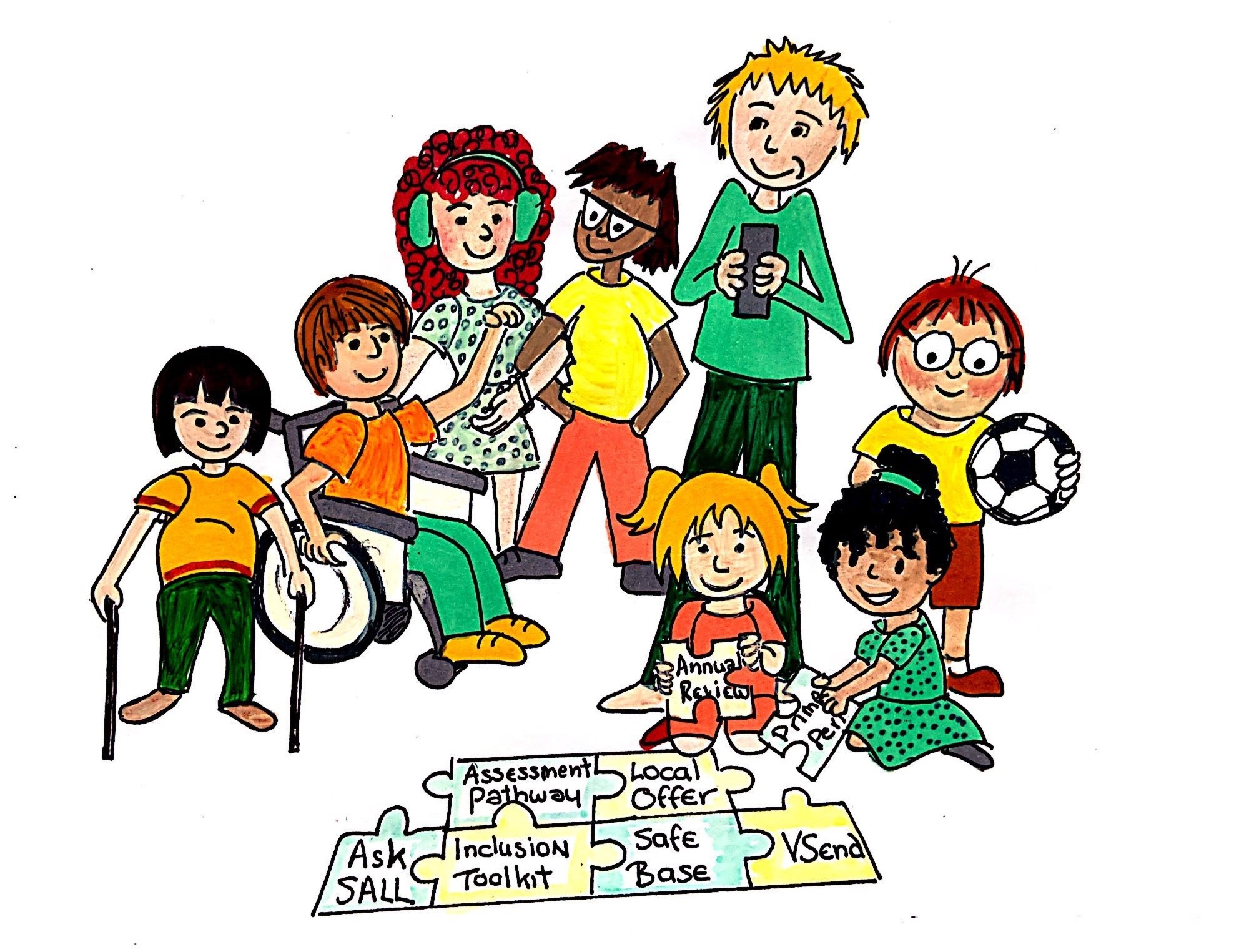Level 1-2 strategies to support high quality teaching
0-5
- High Quality Teaching (HQT) with a specific consideration for children with speech and language needs or social communication needs. Within early years’ settings the key person and manager are accountable for the progress of the child within the setting
- assess through observation or discussion with relevant adults, parents and carers who work with the child (assess)
- plan outcomes to support communication, interaction and emotional wellbeing of child (plan)
- action and support may include:(do)
- continual opportunities for developing early language, speech and social communication including listening and attention skills, understanding (receptive language) and speaking (expressive language)
- communication friendly spaces
- a curriculum that emphasises the development of receptive and expressive language skills to enable children to make relationships and access learning
- visual support and signing in use to create an inclusive environment for all children
- gain the child's attention (say their name and ensure they are looking before giving instructions – let them see your face and get down to their level)
- talk to child about what is happening, what you are doing and what you notice about them as much as possible (a running commentary gives them a greater exposure to vocabulary)
- use simple language and repeat if necessary (chunk instructions by giving one piece of information at a time. Use short sentences and emphasise key words)
- talk calmly and slowly to support child's ability to process words
- give the child thinking time (stay quiet and give the child time to respond to help them process information – ten second rule)
- model correct language (correct grammar and expand sentences by modelling or adding on words to what the child has said and repeating it back)
- encourage the child to ask for help (establish a system for the child to be able to independently ask for help and offer strategies such as pointing, picture symbol, signing, hand up alongside verbal expression where possible)
- use symbols and pictures where possible (add pictures, symbols and/or actions to represent new words or concepts to support their understanding visually)
- sing songs and rhymes
- look at and talk about picture books - as appropriate
- encourage the child to join in with repetitive lines of stories
- have times when you wait for the child to initiate communication (let them start the conversation, listen carefully to what they say and follow their interests – the child will find it easier to talk about something they are looking at or doing)
- get the child to think of words that belong to the same category, for example, as many different animals as they can think of or as many different foods they can think of
5-16
Attention and listening
- get down to the pupil’s level and say the pupil’s name to gain attention
- minimise noise and visual distractions
- simplify your language to the appropriate level
- chunk instructions
- provide visual support to reinforce understanding (objects, photos, pictures, symbols, prompt cards)
- model expectations by showing the pupil what they have to do
- practice and reinforce good looking, good listening, good waiting
- provide explicit praise when they remember and follow the rules
- provide additional processing time
- set time limits for pupils to complete tasks and make visual, For example, sand timer
Speech
- develop phonological awareness (alliteration, segmenting, blending, rhyming)
- provide clear adult models of speech
- sensitively remodel what the pupil has said by repeating it back accurately
- respond positively to what the pupil has said rather than how they have said it
- encourage the use of gesture, objects and signing to support their speech
- use stories, tongue twisters and rhymes with repetitive use of individual sounds to reinforce and highlight clear articulation
- play sound discrimination games
Comprehension
Consider the sensory environment in order to limit distractions.
- modify your language as appropriate. Consider – pace and complexity. Chunk instructions into manageable parts.
- use a multi-sensory approach to teach and reinforce vocabulary and concepts. For example, real objects, concrete situations, photos, pictures, symbols
- make reference to pointing out the phonological structure of words when building comprehension as this helps the word to be more easily remembered and used
- explicitly teach and use classification or categorisation activities to reinforce and extend semantic links
- teach pupils how to recognise when they have not understood and what they could do
- provide opportunities to develop auditory memory
- develop awareness and understanding of question words and narrative structure
Expressive language
- provide opportunities to talk
- to support spoken narrative use real objects, photos, pictures, symbols and explicitly investigate: appearance, where it is found, what it is used for , what category it belongs to
- model the language: Repeat. Emphasise. Expand.
- provide additional processing time in order that the pupil can formulate their response
- use multi-sensory approaches to teach grammatical features
- use colour coding to teach and reinforce grammatical features
- use forced alternatives For example, is it… or …
- use questions to support word finding, for example, what does it look like? can you draw it? can you show me? what is it used for?
- support and scaffold spoken narrative through the use of drama, puppets, story grids, boards and maps
- scaffold writing experiences through the use of story grids, boards or maps
Grammar and syntax
- model appropriate use of grammar
- link speech with writing
- focus on one grammatical feature at a time and ensure that the objective is explicitly shared
- use a multi-sensory approach to teach grammar
- colour code the different aspects of grammar
- play barrier games
- use of sentence makers:
- say the sentence
- write the sentence
- cut the sentence up
- re-sequence the sentence
- social interaction
- provide regular opportunities to learn and play rule based and turn taking games, including, Circle Time
- model appropriate social phrases in context
- use visual support to reinforce expectations and rules, For example, good looking, good sitting, good listening, good waiting
- role play with adult support to mediate as appropriate
- plan opportunities to teach specific skills, For example, listening, turn taking, sharing
- use a range of non-verbal and verbal cues to maintain the topic of conversation
- explicitly encourage topic maintenance through the use of key phrases, For example “you can tell me about that later. now we are talking about…”
- ensure that all members of staff are aware of the pupil’s social interaction difficulties and personal targets and plan
- manage access arrangements for internal and external examinations and assessments. For example, reader or scribe, extra time for assessments as needed. Ensure these are the normal way of working


